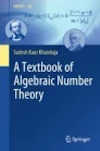- About MAA
- Membership
- MAA Publications
- Periodicals
- Blogs
- MAA Book Series
- MAA Press (an imprint of the AMS)
- MAA Notes
- MAA Reviews
- Mathematical Communication
- Information for Libraries
- Author Resources
- Advertise with MAA
- Meetings
- Competitions
- Programs
- Communities
- MAA Sections
- SIGMAA
- MAA Connect
- Students
- MAA Awards
- Awards Booklets
- Writing Awards
- Teaching Awards
- Service Awards
- Research Awards
- Lecture Awards
- Putnam Competition Individual and Team Winners
- D. E. Shaw Group AMC 8 Awards & Certificates
- Maryam Mirzakhani AMC 10 A Awards & Certificates
- Two Sigma AMC 10 B Awards & Certificates
- Jane Street AMC 12 A Awards & Certificates
- Akamai AMC 12 B Awards & Certificates
- High School Teachers
- News
You are here
A Textbook of Algebraic Number Theory

Publisher:
Springer
Publication Date:
2022
Number of Pages:
271
Format:
Paperback
Series:
UNITEXT
Price:
49.99
ISBN:
978-9811691492
Category:
Textbook
[Reviewed by , on ]
McKenzie West
10/9/2023
A Textbook of Algebraic Number Theory is intended to be used as a 2-term textbook for an algebraic number theory graduate course. Khanduja has distilled the field of Algebraic Number Theory to its most basic parts and presents the content in a precise manner. With a focus on the study of ideals, the author leads readers through basic invariants of number fields and algebraic integers, prime ideals, and factorization. The final chapters discuss class groups and class fields. As a graduate course textbook, this would be an excellent resource.
The text covers the basics of algebraic number theory. The first two chapters get into the basics of algebraic integers, norms, trace, integral bases, and discriminants of number fields. Focusing then on viewing integer rings as Dedekind domains, Chapter 3 works through factorization, norms of ideals, a norm-based generalization of Euler’s theorem. This chapter concludes with the list of negative discriminants that produce complex quadratic extensions whose integer rings are Euclidean domains. The fourth chapter starts with a description of ramification of primes in extensions, ramification index, and residue degree. There is also a section in this chapter on the explicit splitting of primes in quadratic and cyclotomic extensions. We see a statement and proof of Dirichlet’s Unit Theorem in Chapter 5. And again, there is an application to quadratic extensions. Chapter 6 and 7 together include a lot of discussion on relative extensions: prime decomposition, norms, relative discriminants, and relative differents. The final three chapters, 8–10, give a thorough discussion on the class group and class number of a number field. Included in this discussion is a proof of Minkowski and a proof of the Ideal Theorem, which take brief turns to analytic methods. Chapter 10 again brings us through examples in cyclic and quadratic extensions. There is also some conversation of L-functions in this chapter. There are a number of exercises at the end of each chapter to help summarize the content.
This book is a relatively short textbook, especially given its intention to be used over the course of two terms. As a result, there are some examples interspersed within the definitions and theorems but not in large amounts. We see many instances of examples as sections on quadratic extensions at the end of chapters. There is very little prerequisite material covered in the book, which is a reasonable choice given the audience of the text. Relatively speaking, A Textbook of Algebraic Number Theory is a much higher level than Algebraic Number Theory by Frazer Jarvis. This text is also a shorter introduction than Lang’s Algebraic Number Theory, with a heavier focus on norms and ideals. It does not include the class field theory that Lang does. Finally, it’s a much shorter treatment compared to Neukirch’s Algebraic Number Theory. However again, the focus of the content is much different for Khanduja than it is for Neukirch.
I would definitely recommend this book for a graduate course following a thorough abstract algebra sequence. The topics covered are the foundations of the study of algebraic number theory. I would only use this as a book for an undergraduate independent study course if the students were extremely independent and capable of exploring statements and examples on their own.
Mckenzie West is an assistant professor at the University of Wisconsin-Eau Claire. Her mathematical research is in the field of computational number theory and arithmetic geometry.
See the publisher's website.
- Log in to post comments




